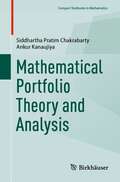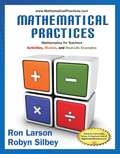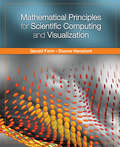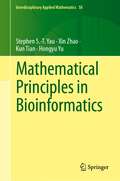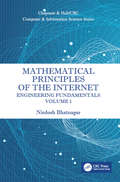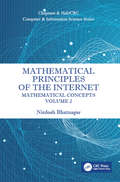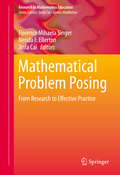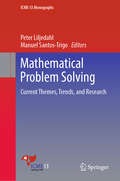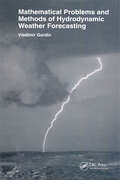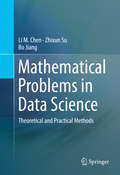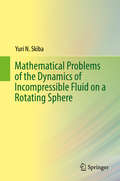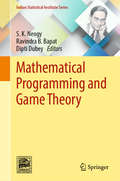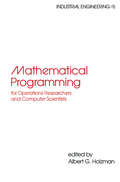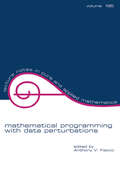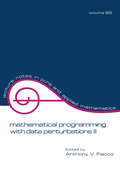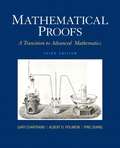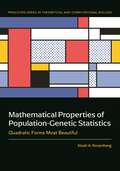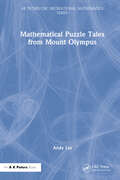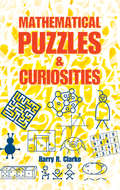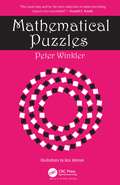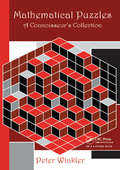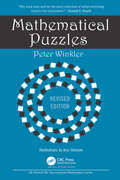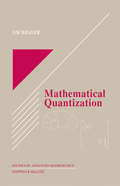- Table View
- List View
Mathematical Portfolio Theory and Analysis (Compact Textbooks in Mathematics)
by Siddhartha Pratim Chakrabarty Ankur KanaujiyaDesigned as a self-contained text, this book covers a wide spectrum of topics on portfolio theory. It covers both the classical-mean-variance portfolio theory as well as non-mean-variance portfolio theory. The book covers topics such as optimal portfolio strategies, bond portfolio optimization and risk management of portfolios. In order to ensure that the book is self-contained and not dependent on any pre-requisites, the book includes three chapters on basics of financial markets, probability theory and asset pricing models, which have resulted in a holistic narrative of the topic. Retaining the spirit of the classical works of stalwarts like Markowitz, Black, Sharpe, etc., this book includes various other aspects of portfolio theory, such as discrete and continuous time optimal portfolios, bond portfolios and risk management. The increase in volume and diversity of banking activities has resulted in a concurrent enhanced importance of portfolio theory, both in terms of management perspective (including risk management) and the resulting mathematical sophistication required. Most books on portfolio theory are written either from the management perspective, or are aimed at advanced graduate students and academicians. This book bridges the gap between these two levels of learning. With many useful solved examples and exercises with solutions as well as a rigorous mathematical approach of portfolio theory, the book is useful to undergraduate students of mathematical finance, business and financial management.
Mathematical Practices, Mathematics For Teachers
by Ron Larson Robyn SilbeyTo become a successful mathematics teacher, you must first become a successful mathematics student. Ron Larson and Robyn Silbey's first edition of MATHEMATICAL PRACTICES, MATHEMATICS FOR TEACHERS: ACTIVITIES, MODELS, AND REAL-LIFE EXAMPLES helps students aspire to be the best educators they can be. Peruse the book and you'll find Classroom Activities integrated into each section; modeling Examples that ask students how to model math concepts in the classroom; real-life Examples that model math concepts students will encounter in their everyday lives; and finally, to frame Ron and Robyn's approach, Common Core State Standards relevant to each lesson to provide future teachers with the knowledge of what their students should know at various grade levels.
Mathematical Principles for Scientific Computing and Visualization
by Gerald Farin Dianne HansfordThis non-traditional introduction to the mathematics of scientific computation describes the principles behind the major methods, from statistics, applied mathematics, scientific visualization, and elsewhere, in a way that is accessible to a large part of the scientific community. Introductory material includes computational basics, a review of coo
Mathematical Principles in Bioinformatics (Interdisciplinary Applied Mathematics #58)
by Xin Zhao Hongyu Yu Kun Tian Stephen S.-T. YauThis textbook introduces bioinformatics to students in mathematics with no biology background assumed and it provides solid mathematical tools for biology students along with an understanding of how to implement them in bioinformatics problems. In addition to the basics, the text offers new approaches to understanding biological sequences. The concise presentation distinguishes itself from others on the subject, discussing and providing principles that relate to current open problems in bioinformatics as well as considering a variety of models. The convex hull principle is highlighted, opening a new interdisciplinary research area at the intersection of biology, mathematics, and computer science. Prerequisites include first courses in linear algebra, probability and statistics, and mathematical analysis. Researchers in mathematics, biology, and math-biology, will also find aspects of this text useful. This textbook is written based on the authors' research works that have been published in various journals along with the lecture notes used when teaching bioinformatics courses at the University of Illinois at Chicago and at Tsinghua University. The content may be divided into two parts. The first part includes three chapters, introducing some basic concepts. Chapter 1 provides biological background in molecular biology for mathematicians. Chapter 2 describes biological databases that are commonly used. Chapter 3 is concerned with alignment methods including global/local alignment, heuristic alignment, and multiple alignment. The second part consisting of five chapters, describes several bioinformatics principles using a rigorous mathematical formulation. Chapter 4 introduces the time-frequency spectral principle and its applications in bioinformatics. In Chapters 5 and 6, two strategies are used, the graphical representation and the natural vector method, to represent biological sequences, and conduct sequence comparison and phylogenetic analysis without alignment. Chapter 7 presents the convex hull principle and shows how it can be used to mathematically determine whether a certain amino acid sequence can be a protein. The last chapter summarizes additional mathematical ideas relating to sequence comparisons, such as new feature vectors and metrics. This part focuses on the governing principle in biology and provides plenty of alignment-free methods, which cannot be found in any other book.
Mathematical Principles of the Internet, Volume 1: Engineering (Chapman & Hall/CRC Computer and Information Science Series)
by Nirdosh BhatnagarThis two-volume set on Mathematical Principles of the Internet provides a comprehensive overview of the mathematical principles of Internet engineering. The books do not aim to provide all of the mathematical foundations upon which the Internet is based. Instead, they cover a partial panorama and the key principles. Volume 1 explores Internet engineering, while the supporting mathematics is covered in Volume 2. The chapters on mathematics complement those on the engineering episodes, and an effort has been made to make this work succinct, yet self-contained. Elements of information theory, algebraic coding theory, cryptography, Internet traffic, dynamics and control of Internet congestion, and queueing theory are discussed. In addition, stochastic networks, graph-theoretic algorithms, application of game theory to the Internet, Internet economics, data mining and knowledge discovery, and quantum computation, communication, and cryptography are also discussed. In order to study the structure and function of the Internet, only a basic knowledge of number theory, abstract algebra, matrices and determinants, graph theory, geometry, analysis, optimization theory, probability theory, and stochastic processes, is required. These mathematical disciplines are defined and developed in the books to the extent that is needed to develop and justify their application to Internet engineering.
Mathematical Principles of the Internet, Volume 2: Mathematics (Chapman & Hall/CRC Computer and Information Science Series)
by Nirdosh BhatnagarThis two-volume set on Mathematical Principles of the Internet provides a comprehensive overview of the mathematical principles of Internet engineering. The books do not aim to provide all of the mathematical foundations upon which the Internet is based. Instead, they cover a partial panorama and the key principles. Volume 1 explores Internet engineering, while the supporting mathematics is covered in Volume 2. The chapters on mathematics complement those on the engineering episodes, and an effort has been made to make this work succinct, yet self-contained. Elements of information theory, algebraic coding theory, cryptography, Internet traffic, dynamics and control of Internet congestion, and queueing theory are discussed. In addition, stochastic networks, graph-theoretic algorithms, application of game theory to the Internet, Internet economics, data mining and knowledge discovery, and quantum computation, communication, and cryptography are also discussed. In order to study the structure and function of the Internet, only a basic knowledge of number theory, abstract algebra, matrices and determinants, graph theory, geometry, analysis, optimization theory, probability theory, and stochastic processes, is required. These mathematical disciplines are defined and developed in the books to the extent that is needed to develop and justify their application to Internet engineering.
Mathematical Problem Posing
by Florence Mihaela Singer Jinfa Cai Nerida F. EllertonThe mathematics education community continues to contribute research-based ideas for developing and improving problem posing as an inquiry-based instructional strategy for enhancing students' learning. A large number of studies have been conducted which have covered many research topics and methodological aspects of teaching and learning mathematics through problem posing. The Authors' groundwork has shown that many of these studies predict positive outcomes from implementing problem posing on: student knowledge, problem solving and posing skills, creativity and disposition toward mathematics. This book examines, in-depth, the contribution of a problem posing approach to teaching mathematics and discusses the impact of adopting this approach on the development of theoretical frameworks, teaching practices and research on mathematical problem posing over the last 50 years.
Mathematical Problem Solving: Current Themes, Trends And Research (ICME-13 Monographs)
by Peter Liljedahl Manuel Santos-TrigoThis book contributes to the field of mathematical problem solving by exploring current themes, trends and research perspectives. It does so by addressing five broad and related dimensions: problem solving heuristics, problem solving and technology, inquiry and problem posing in mathematics education, assessment of and through problem solving, and the problem solving environment. <p><p> Mathematical problem solving has long been recognized as an important aspect of mathematics, teaching mathematics, and learning mathematics. It has influenced mathematics curricula around the world, with calls for the teaching of problem solving as well as the teaching of mathematics through problem solving. And as such, it has been of interest to mathematics education researchers for as long as the field has existed. Research in this area has generally aimed at understanding and relating the processes involved in solving problems to students’ development of mathematical knowledge and problem solving skills. The accumulated knowledge and field developments have included conceptual frameworks for characterizing learners’ success in problem solving activities, cognitive, metacognitive, social and affective analysis, curriculum proposals, and ways to promote problem solving approaches.
Mathematical Problems and Methods of Hydrodynamic Weather Forecasting
by Vladimir GordinThe material provides an historical background to forecasting developments as well as introducing recent advances. The book will be of interest to both mathematicians and physicians, the topics covered include equations of dynamical meteorology, first integrals, non-linear stability, well-posedness of boundary problems, non-smooth solutions, parame
Mathematical Problems in Data Science
by Li M. Chen Bo Jiang Zhixun SuThis book describes current problems in data science and Big Data. Key topics are data classification, Graph Cut, the Laplacian Matrix, Google Page Rank, efficient algorithms, hardness of problems, different types of big data, geometric data structures, topological data processing, and various learning methods. For unsolved problems such as incomplete data relation and reconstruction, the book includes possible solutions and both statistical and computational methods for data analysis. Initial chapters focus on exploring the properties of incomplete data sets and partial-connectedness among data points or data sets. Discussions also cover the completion problem of Netflix matrix; machine learning method on massive data sets; image segmentation and video search. This book introduces software tools for data science and Big Data such MapReduce, Hadoop, and Spark. This book contains three parts. The first part explores the fundamental tools of data science. It includes basic graph theoretical methods, statistical and AI methods for massive data sets. In second part, chapters focus on the procedural treatment of data science problems including machine learning methods, mathematical image and video processing, topological data analysis, and statistical methods. The final section provides case studies on special topics in variational learning, manifold learning, business and financial data rec overy, geometric search, and computing models. Mathematical Problems in Data Science is a valuable resource for researchers and professionals working in data science, information systems and networks. Advanced-level students studying computer science, electrical engineering and mathematics will also find the content helpful.
Mathematical Problems of Classical Nonlinear Electromagnetic Theory (Monographs And Surveys In Pure And Applied Mathematics Ser. #Vol. 63)
by Frederick BloomA survey of some problems of current interest in the realm of classical nonlinear electromagnetic theory.
Mathematical Problems of the Dynamics of Incompressible Fluid on a Rotating Sphere
by Yuri N. SkibaThis book presents selected mathematical problems involving the dynamics of a two-dimensional viscous and ideal incompressible fluid on a rotating sphere. In this case, the fluid motion is completely governed by the barotropic vorticity equation (BVE), and the viscosity term in the vorticity equation is taken in its general form, which contains the derivative of real degree of the spherical Laplace operator.This work builds a bridge between basic concepts and concrete outcomes by pursuing a rich combination of theoretical, analytical and numerical approaches, and is recommended for specialists developing mathematical methods for application to problems in physics, hydrodynamics, meteorology and geophysics, as well for upper undergraduate or graduate students in the areas of dynamics of incompressible fluid on a rotating sphere, theory of functions on a sphere, and flow stability.
Mathematical Proficiency for All Students: Toward a Strategic Research and Development Program in Mathematics Education
by Deborah Loewenberg RAND Mathematics Study PanelA clear need exists for substantial improvement in mathematics proficiency in U.S. schools. The RAND Mathematics Study Panel was convened to inform the U.S. Department of Education's Office of Educational Research and Improvement on ways to improve the quality and usability of education research and development (R&D). The panel identified three areas for focused R&D: development of teachers' mathematical knowledge used in teaching; teaching and learning of skills needed for mathematical thinking and problem-solving; and teaching and learning of algebra from kindergarten through the 12th grade.
Mathematical Programming and Game Theory (Indian Statistical Institute Series)
by Ravindra B. Bapat S. K. Neogy Dipti DubeyThis book discusses recent developments in mathematical programming and game theory, and the application of several mathematical models to problems in finance, games, economics and graph theory. All contributing authors are eminent researchers in their respective fields, from across the world. This book contains a collection of selected papers presented at the 2017 Symposium on Mathematical Programming and Game Theory at New Delhi during 9–11 January 2017. Researchers, professionals and graduate students will find the book an essential resource for current work in mathematical programming, game theory and their applications in finance, economics and graph theory. The symposium provides a forum for new developments and applications of mathematical programming and game theory as well as an excellent opportunity to disseminate the latest major achievements and to explore new directions and perspectives.
Mathematical Programming for Operations Researchers and Computer Scientists
by Albert G. HolzmanThis book covers the fundamentals of linear programming, extension of linear programming to discrete optimization methods, multi-objective functions, quadratic programming, geometric programming, and classical calculus methods for solving nonlinear programming problems.
Mathematical Programming with Data Perturbations (Lecture Notes In Pure And Applied Mathematics Ser. #195)
by Anthony V. FiaccoPresents research contributions and tutorial expositions on current methodologies for sensitivity, stability and approximation analyses of mathematical programming and related problem structures involving parameters. The text features up-to-date findings on important topics, covering such areas as the effect of perturbations on the performance of algorithms, approximation techniques for optimal control problems, and global error bounds for convex inequalities.
Mathematical Programming with Data Perturbations II, Second Edition (Lecture Notes In Pure And Applied Mathematics Ser.)
by FiaccoThis book presents theoretical results, including an extension of constant rank and implicit function theorems, continuity and stability bounds results for infinite dimensional problems, and the interrelationship between optimal value conditions and shadow prices for stable and unstable programs.
Mathematical Proofs: A Transition To Advanced Mathematics (Third Edition)
by Ping Zhang Gary Chartrand Albert D. PolimeniMathematical Proofs: A Transition to Advanced Mathematics, Third Edition, prepares students for the more abstract mathematics courses that follow calculus. Appropriate for self-study or for use in the classroom, this text introduces students to proof techniques, analyzing proofs, and writing proofs of their own. Written in a clear, conversational style, this book provides a solid introduction to such topics as relations, functions, and cardinalities of sets, as well as the theoretical aspects of fields such as number theory, abstract algebra, and group theory. It is also a great reference text that students can look back to when writing or reading proofs in their more advanced courses.
Mathematical Properties of Population-Genetic Statistics: Quadratic Forms Most Beautiful (Princeton Series in Theoretical and Computational Biology)
by Noah A. RosenbergA powerful new approach to interpreting population-genetic data in evolution and ecologyPopulation genetics uses statistical analysis to catalog genetic variation among populations and species. Summary statistics computed from allele frequencies—mathematical functions that measure features of genetic similarity and diversity—are key to this global effort. Yet despite their widespread use in evolutionary biology, ecology, and conservation biology, their mathematical properties have largely been overlooked. This book shows how to use the mathematical bounds on summary statistics to make better interpretations of population-genetic data.Noah Rosenberg discusses how the behavior of these statistics depends not only on the biology of the populations they seek to describe but also on the mathematical properties of the functions used to compute them, properties that produce constraints on the values of the statistics and influence their interpretation. Focusing on the concept of homozygosity—a quadratic function of allele frequencies in a population—he demonstrates how to account for mathematical constraints when measuring genetic similarity and diversity. Rosenberg illustrates the results using examples from empirical data and shares strategies that readers can use to apply this mathematical perspective to different kinds of summary statistics, including those for measuring biodiversity in ecological communities.Drawing inspiration from Charles Darwin, who marveled at evolution&’s &“endless forms most beautiful and most wonderful,&” this book presents a groundbreaking approach to the study of genetic variation. It is sure to stimulate new research in population biology and deeper thinking about the meaning and interpretation of essential measurements of the world&’s genomes.
Mathematical Puzzle Tales from Mount Olympus (AK Peters/CRC Recreational Mathematics Series)
by Andy LiuMathematical Puzzle Tales from Mount Olympus uses fascinating tales from Greek Mythology as the background for introducing mathematics puzzles to the general public. A background in high school mathematics will be ample preparation for using this book, and it should appeal to anyone who enjoys puzzles and recreational mathematics. Features: Combines the arts and science, and emphasizes the fact that mathematics straddles both domains. Great resource for students preparing for mathematics competitions, and the trainers of such students.
Mathematical Puzzles and Curiosities
by Barry R. Clarke"Very satisfying." -- Will Shortz, Crossword Editor, The New York Times. This new collection features an intriguing mix of recreational math, logic, and creativity puzzles, many of which first appeared in the author's Daily Telegraph (UK) column. Requiring only basic algebra skills, classic and new puzzles include The Monty Hall Problem, The Unexpected Hanging, The Shakespeare Puzzles, and Finger Multiplication.
Mathematical Puzzles: A Connoisseur's Collection
by Peter WinklerResearch in mathematics is much more than solving puzzles, but most people will agree that solving puzzles is not just fun: it helps focus the mind and increases one's armory of techniques for doing mathematics. Mathematical Puzzles makes this connection explicit by isolating important mathematical methods, then using them to solve puzzles and prove a theorem. Features A collection of the world’s best mathematical puzzles Each chapter features a technique for solving mathematical puzzles, examples, and finally a genuine theorem of mathematics that features that technique in its proof Puzzles that are entertaining, mystifying, paradoxical, and satisfying; they are not just exercises or contest problems.
Mathematical Puzzles: A Connoisseur's Collection (AK Peters/CRC Recreational Mathematics Series)
by Peter WinklerCollected over several years by Peter Winkler, of Bell Labs, dozens of elegant, intriguing challenges are presented in Mathematical Puzzles. The answers are easy to explain, but without this book, devilishly hard to find. Creative reasoning is the key to these puzzles. No involved computation or higher mathematics is necessary.
Mathematical Puzzles: Revised Edition (AK Peters/CRC Recreational Mathematics Series)
by Peter WinklerResearch in mathematics is much more than solving puzzles, but most people will agree that solving puzzles is not just fun: it helps focus the mind and increases one's armory of techniques for doing mathematics. Mathematical Puzzles makes this connection explicit by isolating important mathematical methods, then using them to solve puzzles and prove a theorem.This Revised Edition has been thoroughly edited to correct errors and provide clarifications, and includes some totally different solutions, modified puzzles, and one entirely new puzzle.Features A collection of the world’s best mathematical puzzles Each chapter features a technique for solving mathematical puzzles, examples, and finally a genuine theorem of mathematics that features that technique in its proof Puzzles that are entertaining, mystifying, paradoxical, and satisfying; they are not just exercises or contest problems.
Mathematical Quantization (Studies in Advanced Mathematics)
by Nik WeaverWith a unique approach and presenting an array of new and intriguing topics, Mathematical Quantization offers a survey of operator algebras and related structures from the point of view that these objects are quantizations of classical mathematical structures. This approach makes possible, with minimal mathematical detail, a unified treatment of a
